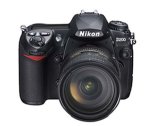 The Nikon D70 was my first digital single lens reflex (DSLR) camera.
The Nikon D70 was my first digital single lens reflex (DSLR) camera.
The D70 was a “downgrade” from my previous Canon EOS 5 in terms of freedom of expression but it was an upgrade in terms of photo quality (some would argue this) and time delay from taking a shot to publishing it online (this is obvious).
After 1.5 years with the D70 I felt I was happy with the results of my new digital work flow and wanted a DSLR that allowed for a bigger technical elbow room.
Meanwhile slightly better models (D70s, D80) had been introduced by Nikon but I felt only the D200 was a significantly more advanced DSLR worth aiming for. The various D1 models were of course too expensive and too professional for my “happy snapping”.
The first thing I noticed while holding the shiny new D200 was the difference in size, weight and build quality. The D200 weighs 35% more (920g vs 680g), has a slightly larger frame and a metal body (D70 is plastic).
Initially your arm will suffer from the extra bulk of the D200 and you will intimidate your subject more easily.
Another thing my wife noticed right away was the lack of scene modes. While the D70 has a few modes for the most common photo situations (sport, beach, portrait, flower and etc.) the D200 lacks them. On the D200 you have to know which camera features to adjust to achieve the same result.
For portraits, aperture priority mode may be used to minimize depth of field, during sports shots you may want to use shutter speed priority with an appropriate speed, photographs of mountains may benefit from manual focus on infinity and so on.
The shooting speed is greatly improved. While I barely managed to get out 2-2.5 RAW NEF frames per second with the D70, the D200 manages up to 5. The shooting speed is dependant on several other factors like shutter speed, memory card quality and resolution but the D200 “feels” at least twice as fast.
The D200 has an overwhelming amount of detailed settings to alter capture properties (saturation, exposure and etc.), button assignments and much more.
It is a bit overwhelming in the beginning but once you know your way around the menus, then all this flexibility will give you a lot of freedom to create unique photographs. The D200 has four setting memories that allow you to swap quickly between favourite groups of settings.
Other notable D200 benefits would be larger view finder and LCD (2.5″ vs 1.8″), multi-channel histograms (YRGB), more autofocus zones (11 vs 5), better resolution (10.2MP vs 6.1MP) and more.
The only thing I miss from my D70 is being able to use the lightweight IR remote control (ML-L3). I used the remote control heavily during night shots (mirror lock-up mode). There is a cord remote available for the D200 (MC-30 or MC-36) but it isn’t as convenient as the ML-L3 was.
My wife finds it more difficult getting sharp photos with the D200 and I suspect this is because the D200 has higher resolution and is overall more sensitive.
This means that some (novice) users may have to practise their techniques (light shutter finger, holding their breath, pan with subject, support arm on something steady and etc.) to get great shots.
With all this flexibility and complexity of the D200 I continuously keep improving my shots. This entry will be a living document where I will be adding any new D200 tricks, tips and techniques I discover and find helpful. Bookmark it and come back for any updates!
1. I often find my self taking several (2-10) shots of the same subject and scene. Afterwards I browse through the shots and eliminate any that are obviously bad (blurry, bad exposure, bad crop).
A great way to do this is to assign the centre of the navigational dial as high zoom and further assign the back command dial to browse between photos.
When you want to review a series of shots, hit the new convenient zoom button and use the command dial to switch between next and previous shots. Because the focus point remains the same while you browse photos, you can now easily compare a subject between multiple shots even if the subject is off centre.
2. I have programmed the front user button to focus. Sometimes I have pushed the shutter button half way but the subject moves and I need to re-focus quickly without loosing exposure lock and composition.
3. I use Vivid colour mode and 1 step of extra sharpness which I find results in photos that require very little post processing and just POP.
4. The auto ISO function is well thought out because you can program it both for the lowest shutter speed you are comfortable with (I use 1/30s) and the highest ISO you are comfortable with (I use 400).
Then you can be sure that the camera will not use a higher ISO for a shot if the exposure can be achieved with or above the shutter speed you have selected.
Skip to content
Online journal and ponderings about the Internet, gadgets and photography.
